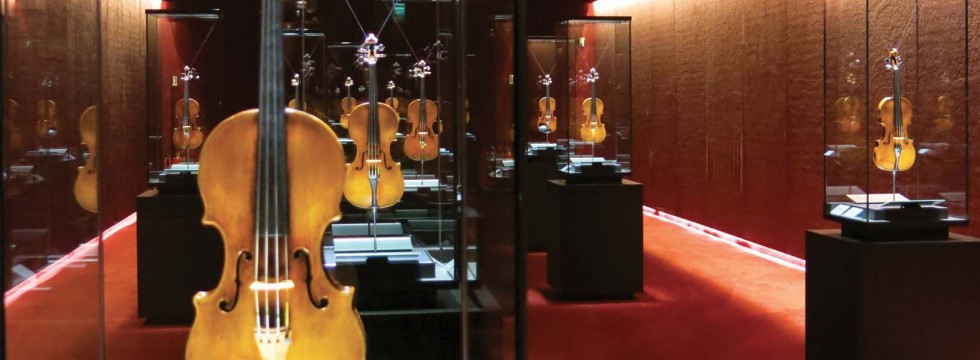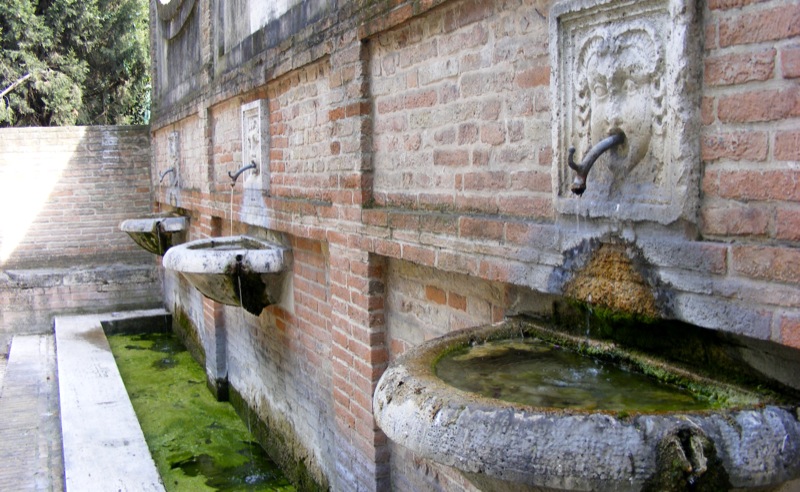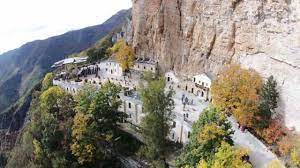
Palaeontologists have made an exciting find in a cave near the fashionable seaside resort of San Felice Circeo (Latina, Lazio). The fossilized bones of seven Neanderthal men and one woman, dating from 50,000 to 68,000 years ago, plus the remains of an even earlier individual, along with bones of hyenas, elephants, cave bears, rhinos and a long extinct giant auroch, have been discovered in a previously unexplored area of the Guattari Grotto.
The Grotto, situated near the sea in the protected area of the Nature Park of the Circeo peninsula, was first discovered in 1939 and produced an exceptional find: the perfectly preserved skull of a Neanderthal man, placed inside a circle of stones. The skull is now in the prehistoric Luigi Pigorini Museum of Prehistory and Ethnography in Rome.
The present research campaign was carried out by the Archaeology & Arts Superintendency of Frosinone and Latina Province in collaboration with the Tor Vergata University of Rome.
Italy's Culture Minister Dario Franceschini, described the find as “extraordinary”, while Mauro Rubini, director of the local Department of Archaeology, Fine Arts & landscape said that Neanderthal man was a fundamental link in human evolution and the discovery gave valuable insight into the process of human settlement in Italy.
Italy is not new to prehistoric finds that made world news. In 1998 the fossil of a baby Scipionyx dinosaur of 113 million years ago was discovered at Benevento (Campania), exceptionally with much of its intestine still intact, allowing scientists to analyse its diet. The dinosaur is affectionately nicknamed “Ciro”.

A little known aspect of the life of the great Italian composer Antonio Vivaldi is being highlighted in the exhibition “I Violini di Vivaldi e le Figlie di Choro” (The Violins of Vivaldi and the Daughters of the Choir), recently opened in Cremona (Lombardia), world leader in the creation of unique and precious bowed string instruments, perfected by master craftsmen like Stradivari, Amati and Guarneri.
The exhibition features rare pieces from the Music Chapel collection of the Ospedale Santa Maria della Pietà (Hospital of St. Mary of Pity) in Venice, an illuminated orphanage for abandoned baby girls founded in 1346 and unique in Europe. Antonio Vivaldi, known as the “Red Priest”, thanks to his fiery-coloured locks, was Concert Master at the Ospedale from 1703 to 1740, where he personally undertook the musical education of the “putte” (young girls) so that they would be able to earn their living as musicians when they left the orphanage. Several of the violins, violas and violoncellos on show come from the collection of over fifty instruments chosen personally by Maestro Vivaldi for his pupils, who were known as the Figlie di Choro (Daughters of the Choir). The girls performed in the adjacent Church of Santa Maria della Pietà, hidden behind a grill to protect them from the eventual evil intentions of pimps and libertines.
The exhibition marks the reopening of the Violin Museum of Cremona after the long Covid epidemic lockdown and gives music lovers the opportunity to see early versions of bow and string instruments of the Venetian and German schools and their subsequent development.
The Hospital of Santa Maria della Pietà continues to function after eight centuries and is considered part of the cultural heritage of Venice. It is now a recognized charitable institution supported by the Veneto Regional government, offering help and support to mothers and children in difficult situations, irrespective of race or religion.
The exhibition is scheduled to run until the 1st August 2021 at the Violin Museum, Cremona.
M Stenhouse
Info: Tel. +39.0372080809 www.museodelviolino.org www.pietavenezia.org

The Umbria city of Perugia won first place in the 5th edition of the Art Bonus Project of the Year, with the restoration of the Fountain of San Francesco at San Giovanni Bridge. The medieval fountain takes its name from St. Francis of Assisi, who, according to tradition, stopped there in 1202 to drink and wash his wounds after the Battle of Collestrada, fought between the city states of Perugia and Assisi.
The Art Bonus is a scheme that supports Italian culture through tax concessions for charitable donations, granted to individuals or organizations. Since the year of its introduction in 2014, it has attracted over 550 million euros in total funding for projects regarding historical monuments, museums, archives, libraries and the theatre.
Umbria region also gained another nomination in this year's list of finalists, for the National Gallery of Umbria with the Ministry of Culture (MiC) project of “The Divine Painter” and his school, encompassing Perugino and the Umbria Cinquecento.
Info: Tel. +39.339.7807729 info@umbriacultura.it www.beniculturali.it

The Italian espresso coffee ritual was expected to be included in the UNESCO Intangible Cultural Heritage list announced at the end of March 2021. However, there was a hitch. The committee found itself presented with two candidates for the same title: one from the north of Italy and the other from Naples, both claiming to be the rightful custodians of the authentic espresso tradition.
Result: the judges told them to go away and reach an agreement to put forward one single united candidacy for the next edition.
Coffee is a major business in Italy, giving employment to some 10,000 workers, according to the Istituto Nazionale Espresso Italiano (ISI). The Italian espresso ritual is a “must” in the morning (usually taken standing up at the bar counter) and during work breaks with colleagues and business associates. An estimated 3 billion cups are consumed every day,
Italian espresso, however, has had some consolation in the form of a tribute paid this spring by the USA, with a special postage stamp issue dedicated to the western world's beloved beverage. The new collection features the four most popular coffee preparations: Espresso, Caffé Mocha, Cappuccino and Caffé Latte (the latter even given its proper name and not the abbreviated form of “latte” favoured in the English-speaking world). The designated city of issue is Seattle, famed for its coffee bars and known as the American city that consumes most coffee.
Info: www.espressonapoletano.net www.espressoitalianotradizionale.it

Anyone driving along secondary roads in Italy will be familiar with the red coloured houses set at intervals along the way. These are the Case Cantoniere which once served as residences for the roads-men and their families, called after the “Cantonieri”, or the workmen responsible for the maintenance of a certain tract of road. Built in the early 20th century, these houses were set near the roadside and all were characteristically painted a bright Pompeiian red to make them readily visible.
The houses are state property, under the control of the Ministry of Infrastructure and Transport, and most have been abandoned for many years now since the traditional role of roads-men no longer exists. There are a total 1,244 of these houses distributed all over Italy, including the island of Sardinia.
Finally, however, ANAS (Azienda Nazionale Autonoma delle Strade dei gruppo FS Italiane – the Autonomous National Road Company – now part of the State railways group) has decided to put some of them on the market with a twenty year lease formula at attractive rates.
The first batch of a hundred of these houses is already available, but the properties come with certain conditions. The outside must not be altered nor the distinctive ANAS sign removed. They must also be redecorated in the traditional Pompeiian red, codified by the Ministry of Culture and Heritage as RAL3001. New concession preferences go to non profit associations but the houses could also be converted into sales points for local products, centres for cultural activities, bars, b&b and country restaurants.
Applications to purchase a Casa Cantoniere must be submitted by mid-day on the 15th June 2021 through the ANAS portal.
Info: www.stradeanas.it/casecantoniere

One of Italy's greatest commercial successes – the Vespa scooter – celebrates its 75th anniversary this year with the launch of new, limited editions of the series Primavera and GTS, only available during 2021 and destined to become collectors' pieces. The new models have their own special features and a brand new metallic yellow colour, labelled Giallo 75th.
The first single model motor scooters were launched by the Piaggio engineering company of Pontedero in Tuscany in 1946. Designed by aeronautic engineer Corradino D'Ascanio, the prototype was created from spare aircraft parts, pieces of landing gear from Mussolini's wartime airships. Contrary to popular legend, the name Vespa (“wasp” in Italian) was not inspired by the buzzing of its engine but instead by its silhouette, seen from above by factory owner Enrico Piaggio who said it reminded him of the shape of a wasp.
The elegant little city scooter revolutionized the concept of the cumbersome old army motorcycle and was instantly seen as a symbol of freedom and youth. The Vespa became a worldwide icon with its starring role in the film “Roman Holiday” with Hollywood actor Gregory Peck as a young reporter, zipping around the streets of the Eternal City with the Princess-in-disguise Audrey Hepburn perched on the pillion.
As soon as the pandemic lockdown is over, fans will be able to enjoy a visit to the Vespa Museum, inaugurated in 2000 inside the old tooling area in the historic Piaggio factory floor. Meanwhile, virtual tours are available on the museum website.

Le ova' mpriatorio (eggs in Purgatory) is a traditional Neapolitan dish, the origins of which are lost in time. The recipe involves eggs cooked in tomato sauce so that the egg white turns red to symbolize souls in Purgatory struggling to escape from the surrounding flames. Variations of this simple but tasty dish abound all over Italy and are having a bit of a revival due to the celebrations of the 700th anniversary of the death of Dante Alighieri in 1321.
According to a popular legend, the Great Poet's favourite food was eggs. The story goes that he was sitting on his habitual stone outside the Cathedral in Florence when a passerby asked him what he enjoyed eating most and Dante replied “A boiled egg”. When the same person passed some time after, he asked: “With what?” And Dante answered “With salt”.
What the author of “The Divine Comedy” actually preferred to eat is unknown, however, Dante's alleged stone still sits against the south wall of the Cathedral and attracts many tourists. The “Stone” is actually a lump of rock, rather uncomfortable for sitting on. Probably there was actually a stone bench on the spot once upon a time.
M. Stenhouse
Info: www.portanapoli.com
 The recent cold spell has held up the arrival of swallows, house martins and swifts this year, according to LIPU (Lega Italiana Protezione Uccelli), the Italian Society for the Protection of Birds.
The recent cold spell has held up the arrival of swallows, house martins and swifts this year, according to LIPU (Lega Italiana Protezione Uccelli), the Italian Society for the Protection of Birds.
For the last few years, LIPU has denounced a steady decrease in the numbers of these birds, symbols of spring. One of the reasons is the reduction of suitable habitats, especially in the case of the house martin, which builds its nest of mud and straw under overhanging gables and cornices. These features have largely disappeared in modern buildings, leaving less and less space for the birds to reproduce.
Efforts to make amends, however, are arriving from some unexpected areas. The abandoned electricity plant ENEL at Piombino (Tuscany), earmarked for demolition, is creating an alternative structure to house the colony of two hundred nesting birds concentrated under the eaves of the former engine-room. ENEL, with the backing of a group of conservation partners - the WWF Nature reserve of Padula Orti-Bottagone, the Italian Swallow and Swifts Group and the Swift Conservation organization, has commissioned architect Riccardo Stoppioni to build a replacement steel structure, complete with a string of artificial nests for the birds.
Similar initiatives are being carried forward in Parma with tunnel entrances to garages which reproduce the former nesting places in farm barns. In addition, the medieval Hospital and desecrated Church of San Francesco Del Prato is being adapted to accommodate the birds by opening up all the old gaps which were in the facade and were subsequently blocked. These holes, however, will only be big enough to let the swallows use them and not the pigeons, which would otherwise move in and take over the nesting spaces!
Info: www.lipu.it

One sector that has held up well in Italy despite the current crisis is the cheesemaking industry. The world famous Parmigiano Reggiano saw a production increase of 4.9% in 2020, while its “little sister”, Grana Padana, registered a sales increase of 4.3%, according to latest figures published by AFIDOP, the Italian Cheesemakers Association.
The most interesting up-and-coming Italian cheese, however, is ewe's milk cheese – collectively known as “pecorino”, with its main production areas in Sardinia and in Lazio. The town of Bracciano, that overhangs the lake of the same name, has been nominated “City of Cheese 2021” by the National Organization of Cheese Tasters (ONAF Italia) to encourage the production of the local speciality cheese, Caciofiore di Columella, and launch it on the international market. Only four cheesemakers in the region still produce this cheese, which has a noble history, dating back to ancient Roman times.
Info: Tel. +39.02.72021817 www.afidop.it www.onaf.it

The birth of a baby can become a big event in a country like Italy where the birth rate continues to fall dramatically. In a little town like Vallepietra (Lazio), the 300 inhabitants are celebrating the arrival of the first baby born into their community during the past six years.
The parish priest set all the church bells ringing to greet the new arrival and the citizens were out in the street in force to applaud the proud young parents when they arrived home with their new born girl. The devout were convinced that their prayers had finally been answered.
Vallepietra is a well-known centre of pilgrimage, with its ancient Sanctuary of the Trinity, tucked among the rugged mountains in the heart of the Monte Simbruini Regional Nature Park. The little church contains an 11th century fresco of three seated figures, each holding a book in the left hand and with the right hand raised in blessing.
Info: www.santuariovallepietra.it
<< Previous ... 2 ... 4 ... 6 ... 8 ... 10 ... 12 ... 14 ... 16 17 18 19 20 21 22 23 24 25 26 27 28 29 30 31 32 33 34 35 36 ... 38 ... 40 ... 42 ... 44 ... 46 ... 48 ... 50 ... 52 ... 54 ... 56 ... 58 ... 60 ... 62 ... 64 ... 66 ... 68 ... 70 ... 72 ... 74 ... 76 ... 78 ... 80 ... 82 ... 84 ... 86 ... 88 ... 90 ... 92 ... 94 ... 96 ... 98 ... 100 ... 102 ... 104 ... 106 ... 108 ... 110 ... 112 ... 114 ... 116 ... 118 ... 120 ... 122 ... 124 ... 126 ... 128 ... 130 ... 132 ... 134 ... 136 ... 138 ... 140 ... 142 ... 144 ... 146 Next >>



